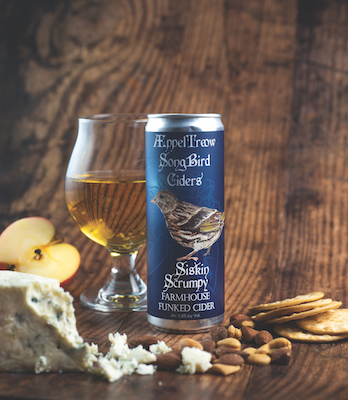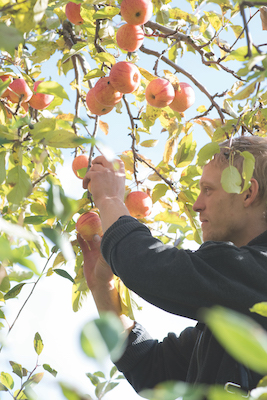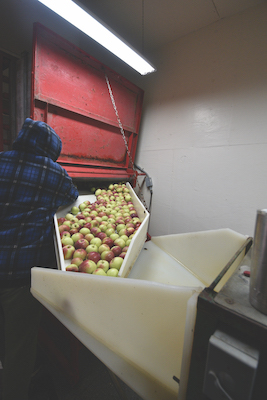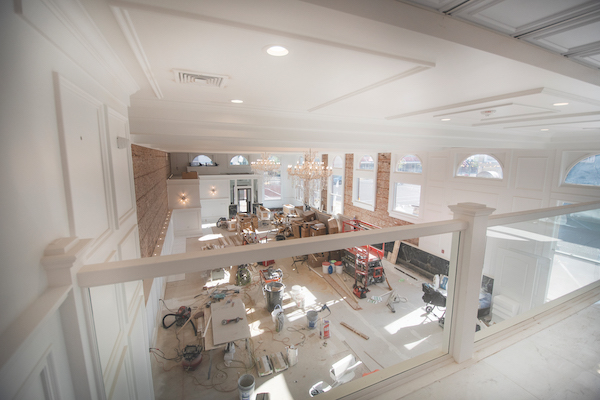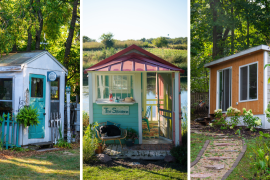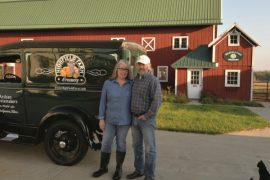Story And Photos By Holly Leitner
Autumn is upon us. Suddenly the air is crisp, a northwest wind promises plunging temps and falling leaves. It’s time to snuggle into our favorite flannels and sip a beverage that has been enjoyed for generations — hard cider.
Hard cider’s roots run deep in American culture. In Colonial America it was once the prevailing drink of choice — known simply as “cider” — 10 times more popular than beer and enjoyed year-round. By 1775, one in 10 New England farm families had a cider mill. Even the Founding Fathers imbibed in it before signing the Constitution. John Adams, who would become president in 1797, wrote that he would drink a gill (1/4 pint) of hard cider each morning to put his stomach at ease. Thomas Jefferson made cider at Monticello and served it at meals regularly. Over the years, due to socioeconomic and cultural reasons, cider started to lose its popularity as it was cheaper to grow hops and make beer. Then with a final blow from the Temperance Movement, orchards were burned to the ground and only trees producing baking apples survived.
Fast forward 100 years. Today, apple orchards flourish and there’s been a revival of cider akin to the craft beer revolution. Across the country, farmhouse cidermakers are exploring this small, yet fast-growing industry by introducing artfully done, old-world style cultivar and terroir-driven ciders.
AN EVER-EVOLVING CRAFT
One such entrepreneur works in the outskirts of Burlington. In a small, 1930’s dairy barn turned cidery, life has picked up where it left off pre- Prohibition. Pungent apple notes cling to the rustic walls, brown bottles glisten in the soft light and friendly faces offer tastings of the latest creation. An uber focused Charles McGonegal meticulously ferments, blends, sips and documents. What started as a cider/ mead-making project when he was in college, has grown into an artisanal cider, perry and spirits business that has been in operation for more than 20 years. McGonegal, a chemist by day and cidermaker by night and weekends, with his wife, Milissa, own ÆppelTreow Winery & Distillery — the name derived from Old English for “apple tree” and “apple truth,” or simply apple true.
When he started partnering with Brightonwoods Orchard more than 20 years ago, the orchard grew 120 different apple varieties. Today, they cultivate 200 heritage varieties that McGonegal uses for his ciders. These are not your everyday Macintosh or Red Delicious, commonly found in the grocery store, these are varietals not grown for eating or a long shelf life, but for pressing, similar to wine grapes. They have sharp tannins giving them the ability to transform into beautiful ciders. Since cider is fermented fruit juice, it is technically considered wine.
“We are not fruit wines; we are a cidery,” says McGonegal. “We are showing off cultivar and terroir and history. Cider making is a blender’s art,” he says enthusiastically.
Today’s artisanal cidermakers like McGonegal, explore a cider’s terroir, the French term that poetically sums up the magic combination of soil, topography, climate and farming practices or philosophy. Cultivar is a term for varietal — just as winemakers explore certain grape varietals such as cabernet sauvignon, merlot and chardonnay — cidermakers have hundreds of apple varietals as well. In fact, it’s much more commonplace to have blended ciders versus blended wines.
True hard ciders are meant to be mostly dry, back sweetened with juice, with very low starting sugar. This is because fermentation eats up the apple’s low sugar (compared to that of grapes or other fruits), leaving it naturally drier. Since the American palate generally prefers sweet tastes, many popular national cider brands contain added sugar.
THE CIDER MAKING PROCESS
The key to good cider is good apples. As with any natural drink, the cider making process starts with the quality of the fruit. It typically takes McGonegal about seven to 10 years to make a first batch, and as he says, “to weed out the boring apples.”
During harvest time, McGonegal checks the orchard once or twice a week. He explains that during this time he’s determining the perfect moment to pick — when the fruit is ripe, but not too late that it will begin to fall. The French and English way of harvesting is to actually collect fallen apples from the ground. U.S. laws won’t allow this method, plus this leads to an old-world flavor profile that’s musty and earthy. ÆppelTreow’s apples are all handpicked. It’s often a painstaking process: hands often cramp due to precision cutting techniques, then there are the scrapes from thorns, and typically those harvesting are wet from head to toe because it’s better to pick in the rain than to fight with the bees.
After harvesting, the apples travel on a conveyor belt where they are examined. Any bad apples or debris are discarded and the apples are washed. Next, the apples are put into a large mill and ground to a fine pulp that is the consistency of applesauce.
Then, they go through a pressing process, which removes the pulp and releases the cider. Plastic racks, lined with nylon cloth, are filled with pulp and then stacked on top of each other. The entire stack is put into a large, stainless steel tray under a cider press. The cider is pumped through tubes to the cooling tank, then stored at 33 F. Cider is fermented in a tank for up to a month or more.
During the last steps, the cider is filtered again and pumped into appropriate packaging. ÆppelTreow has its own in-house bottling line.
TAKE A TASTE TEST
ÆppelTreow offers tastings that include a flight of five ciders made up of their sparkling, draft and still ciders and their dessert wines and spirits.
Their popular, sparkling-style cider is crafted using the Champagne method. These can range from dead dry to semi- sweet, such as the Appely Brut Cider, which is dry, crisp and minerally.
Next up is a draft-style cider, which is made in the English tradition with an alcohol content similar to craft beer. These range from traditional to more modern options flavored with spices and other fruits.
The third sample is a still cider, which you’ll find similar to a white wine. ÆppelTreow’s Pear Wine can be characterized as semi-sweet mellow, blossoming and with hints of spice. Their Summer’s End Apple Wine is reminiscent of a riesling or chenin blanc.
Next is their category of dessert or fortified wines called mistellas, including the Poirissimo Pear Dessert Wine.
And lastly, you’ll sample their small batch whiskey, brandy and gin.
McGonegal’s product offerings have come a long way from his early college mead making days, but yet he still feels there is more to explore. He’s an active member of national and international cider organizations and frequents cider summits.
“I thought we would branch out into fruit wines,” he says, “but with 200 varieties, I’m not done with apples yet.”
A visit to ÆppelTreow Winery & Distillery is a history lesson accompanied by interesting insight about the crafting of this refreshing lineup of hard ciders, wines and spirits. You’ll be transported to an early time with your first sip.
For more information about ÆppelTreow Winery & Distillery, visit aeppeltreow.com. For up-to-date tasting hours and specials, please visit their Facebook page.


